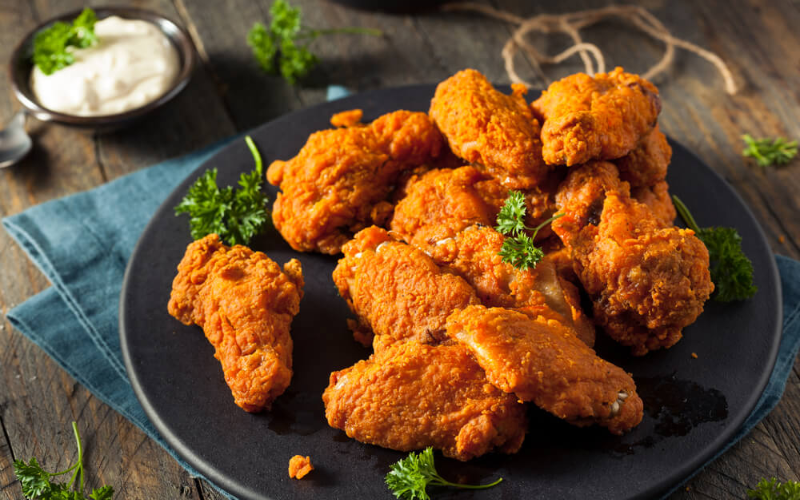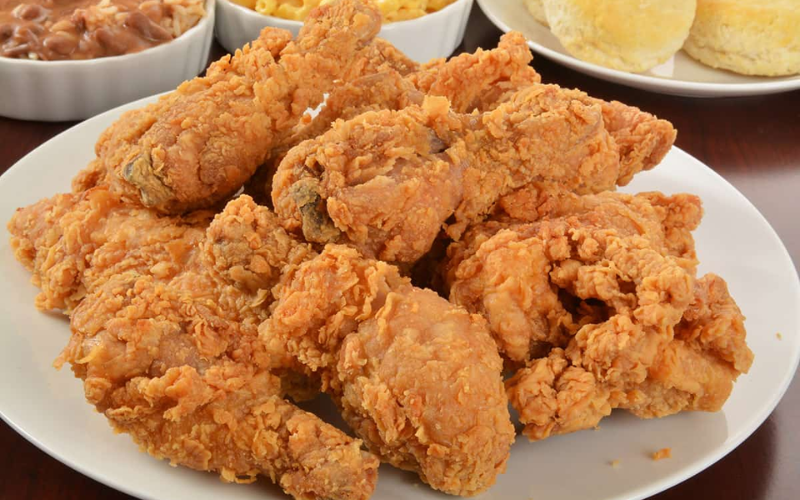
The Universal Pull of Comfort Food
Some foods don’t just fill your stomach — they fill a gap in your heart. Fried chicken is one of those dishes that seems to say, “you’re home,” no matter where you are.
There’s something deeply human in the sound of hot oil crackling, the scent of seasoned batter filling the kitchen, and the first bite that crunches just right. It’s more than flavor — it’s feeling.
Why is it that from the American South to street stalls in Asia, so many people crave fried chicken? Maybe it’s the familiarity, the way it cuts across culture and class. Or maybe it’s because it doesn’t try too hard — it’s honest, warm, and shared.
Where other comfort foods differ from country to country, fried chicken feels universal. It’s spicy in one place, sweet in another, but always recognizable — always comforting.
Key Takeaways
-
Fried chicken’s journey from regional specialty to global comfort reflects migration, memory, and shared cultural love for taste and texture.
-
The dish blends accessibility with emotion — a symbol of togetherness and warmth across generations.
-
Its adaptability allows endless variations, from spicy African styles to sweet Korean versions.
-
Despite diet trends, fried chicken’s sensory allure makes it evergreen.
-
From Seoul to fried chicken, every version celebrates comfort and connection in its unique way.
Roots Deep in History
The story of fried chicken runs deeper than its crispy surface. It’s a blend of tradition, survival, and creativity. Though versions of fried poultry existed in Europe, what became known as “American-style” fried chicken found its identity in the South.
Enslaved Africans in the early American South brought frying techniques and bold seasonings that shaped the dish we now know. For them, chicken wasn’t just a meal. It symbolized resilience and resourcefulness; poultry was often one of the few things they could own and cook freely. On special days, frying that chicken turned a humble bird into something sacred.
When generations later, families migrated north during the Great Migration, they carried those recipes — and the feeling that came with them. Soon, Southern-fried chicken became more than a regional dish; it became a statement of cultural pride and comfort.
And when travelers and entrepreneurs introduced it overseas, local cooks reinvented it again and again. The result? A dish that belongs to everyone but still remembers where it came from.
Why Fried Chicken Travels So Well
Some foods can’t leave home; they lose their essence outside their birthplace. Fried chicken, though, thrives everywhere. It’s adaptable — it happily takes on local spices, oils, flours, and frying methods without losing its soul.
-
In Japan, fried chicken became karaage — bite-sized pieces marinated in soy sauce, sake, and ginger.
-
In Korea, chefs double-fry it, giving it that glass-like crispness, often tossing it in sweet and spicy sauces.
-
In Nigeria, fried chicken sears with chili, pepper, and bold seasoning that mirror African intensity.
-
In the Philippines, it’s soaked in flavor, often paired with banana ketchup.
-
And in the American Midwest, including places serving fried chicken, it’s reimagined with artisanal flours, local honey glazing, and modern flair.
That’s why the dish continues to resonate worldwide. It’s not just food — it’s an edible passport connecting streets, homes, and hearts.
The Science of That Irresistible Crunch
If you’ve ever wondered why one bite can lift your mood instantly, science has answers.
The combination of fat, salt, and texture triggers your brain’s pleasure receptors. The crispy coating breaks apart with a satisfying crunch, releasing aromas of seasoning and caramelized protein. These signals tell your brain: this is joy.
Sound plays its part too. That familiar crackle when you bite in engages senses beyond taste — it’s the ASMR of real life. Add a juicy, tender interior, and you get a balanced contrast of crunch and softness that few dishes can rival.
But beyond the chemistry, the emotion matters just as much. Eating fried chicken often carries memories — gatherings, family, weekends, laughter — creating neural links that go deeper than flavor. You don’t just taste it; you remember it.
Fried Chicken’s Cultural Identities

Across the globe, fried chicken wears different cultural outfits — each suited to local taste but rooted in the same comfort.
-
Japan serves it small and delicate — karaage with ginger tang, dipped lightly in seasoned flour.
-
Korea goes bold and social — chicken shared over beers, coated in soy garlic or fire-red gochujang sauce.
-
Africa adds depth — spice-heavy versions that tell ancestral stories through flavor.
-
Southeast Asia uses coconut oil and spices that make each bite fragrant and crisp.
-
The U.S. South keeps tradition alive — family recipes with peppered seasoning, served alongside biscuits and gravy.
Each version is proud of its difference, yet all share one thing — fried chicken as a gesture of welcome. It’s what you cook when words don’t feel enough.
Why We Call It Comfort Food
Comfort food isn’t just about taste. It’s the emotional shortcut it gives you. Fried chicken fits that definition perfectly.
It reminds people of home — the grandmother stirring flour with her hands, the smell of oil that fills the air before dinner, the chew that tastes like memory. It’s a dish people turn to when they need grounding, celebration, or a little joy after a hard day.
Psychologists even note that comfort foods like fried chicken release dopamine — the “feel-good” chemical. Pair that with nostalgia, and you’ve got an unbeatable combination of biology and emotion.
The Togetherness of Fried Chicken
Fried chicken is a social food at heart. You rarely eat it alone. It sits in the center of tables — at family reunions, game nights, picnics, festivals. There’s a kind of unspoken warmth in passing around a plate of golden, fragrant wings.
It’s not fancy, and that’s the beauty. It breaks the boundaries between formal and casual, rich and poor. That’s how fried chicken remains timeless — it unites people across situations and tempers moods with a single bite.
The Role of Pop Culture and Media
Pop culture turned fried chicken into more than a meal — it became a symbol. From soulful music references to trending mukbang videos, fried chicken has become media currency.
In films, it shows up when a character seeks comfort; in TV series, it’s the mess you don’t mind when you’re laughing with friends. Social platforms now amplify it, with slow-motion crunch videos and sizzling sounds gathering millions of views.
The narrative always comes back to the same truth: this food comforts. Whether in nostalgia-driven cooking shows or viral challenges, the message stays universal — fried chicken equals happiness.
Reinventing the Classic for a Modern World
The beauty of fried chicken lies in its flexibility. It’s constantly being reborn without losing its essence.
In an era where health and sustainability matter, chefs experiment with air fryers, alternative oils, and even cauliflower-based “chicken.” Yet at heart, the old charm remains. The best innovations don’t erase tradition — they build on it.
You’ll find it in upscale food trucks with infused sauces or home kitchens keeping age-old recipes alive. And in cities like Champaign, food lovers have found ways to blend world spices with local simplicity — proof that comfort food can be both nostalgic and forward-thinking.
Through all the changes, one thing stays consistent: that first satisfying crunch that reminds you life’s simple pleasures still matter.
Fried Chicken as Memory and Story
Every bite of fried chicken tells a story. A grandmother teaching her granddaughter the right oil temperature. Friends celebrating on a summer evening. A lonely traveler finding home in a small diner.
Memory clings to food like seasoning does to chicken. That’s why fried chicken keeps showing up when people talk about “home.” It travels not just through recipes, but through emotions passed down.
It connects generations — linking the hands that cooked it decades ago to the people who make it now, experimenting but still respecting where it began. That continuity makes it more than food; it’s a lineage.
What Makes Fried Chicken Global
Ask ten people what makes fried chicken special and you’ll likely get ten answers — yet all hint at the same idea: comfort through connection.
Its global success stems from accessibility. You don’t need wealth or rare ingredients to make it. It fits any occasion, from street markets to fine dining. And because every culture knows some form of fried food, it feels familiar everywhere.
There’s also an emotional truth to it. Fried chicken doesn’t pretend to be anything other than what it is — satisfying, crunchy, joyful. That honesty transcends language.
Why It Keeps Winning Against Food Trends

Diet trends rise and fall. But fried chicken stays. Why? Because it offers something you can’t package in a calorie count — satisfaction.
People crave the comfort of texture, the release of nostalgia. You can make healthier versions, air fry it, bake it — but somehow, the traditional deep fry, golden and fragrant, never loses appeal.
Even in wellness-focused times, fried chicken continues to appear on menus. It’s that taste of small rebellion, that reward after a long week, that reminder that pleasure has its place too.
Conclusion
Fried chicken’s rise from humble roots to global comfort champion isn’t an accident. It mirrors humanity’s hunger — not just for taste but for connection. Across borders, tongues, and ages, the simple act of seasoning, frying, and sharing chicken remains a universal language of care.
For those seeking a delicious experience in the Midwest, indulging in fried chicken in Champaign, IL, highlights both comfort and culinary tradition in every bite.
Fried chicken stands as proof that food can bridge cultures, soothe emotions, and carry memory. It doesn’t belong to one place or one people anymore; it belongs to everyone who’s ever needed the comfort of something familiar, hot, and delicious.
FAQs
1. Why is fried chicken seen as comfort food?
Because it connects flavor, emotion, and memory — the trifecta that defines comfort. Its familiar crunch and warmth make people feel grounded.
2. How did it spread worldwide?
Through migration, cultural exchange, and adaptation. Each place added local ingredients, creating countless interpretations.
3. What’s the secret behind perfect crispiness?
A balanced coating, right oil temperature (around 350°F), and patience while frying. Double-dipping the batter often locks in texture.
4. How are modern chefs reimagining it?
Some use unique oils, spiced crumb coatings, or plant-based substitutes while keeping the nostalgic feel intact.
5. Why does fried chicken remain timeless?
Because it speaks to basic human needs — comfort, connection, and joy — transcending time, trend, and geography.





